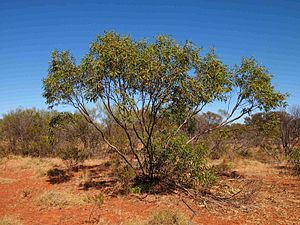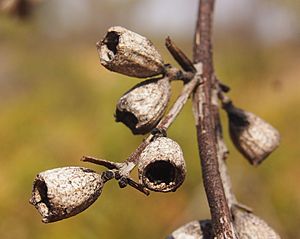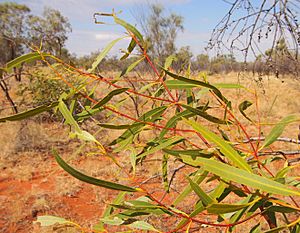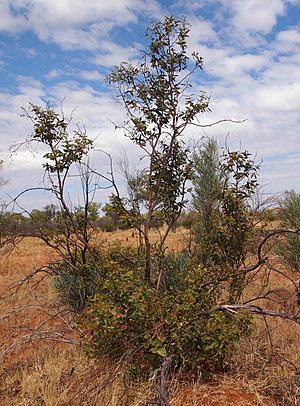Sturt Creek mallee facts for kids
Quick facts for kids Sturt Creek mallee |
|
|---|---|
 |
|
| E. odontocarpa habit | |
| Scientific classification | |
| Genus: |
Eucalyptus
|
| Species: |
odontocarpa
|
The Eucalyptus odontocarpa, also known as the Sturt Creek mallee, is a type of plant that grows naturally in northern Australia. The local Aboriginal people call this plant Warilyu.
What Does It Look Like?
This plant is a type of mallee, which means it has many stems growing from the ground. It usually grows to be about 1.5 to 5 meters (5 to 16 feet) tall. The bark on its stems and branches is smooth. It can be grey, brown, or even a coppery color. Sometimes, it might be white, cream, or pink. The bark often peels off in small pieces or ribbons.
The Sturt Creek mallee has white flowers that bloom between April and July. Its leaves are shiny green and grow in pairs. They are long and narrow, usually 5.5 to 19.5 centimeters (2 to 7.5 inches) long and 0.5 to 1.8 centimeters (0.2 to 0.7 inches) wide. Each leaf has a small stalk, called a petiole, about 0.5 to 1.7 centimeters (0.2 to 0.7 inches) long.
After the flowers, the plant produces small, woody fruits. These fruits are shaped like a cylinder, barrel, or cup. They are about 0.7 to 1.4 centimeters (0.3 to 0.5 inches) long and 0.5 to 0.7 centimeters (0.2 to 0.3 inches) wide. Inside these fruits are flat, dull grey seeds, which are about 4 to 6 millimeters (0.15 to 0.23 inches) long.
How It Was Named
The Sturt Creek mallee was first officially described by a botanist named Ferdinand von Mueller in 1859. He found the plant along Sturt's Creek in the Northern Territory in 1856.
The name odontocarpa comes from two ancient Greek words. "Odous" (or "odontos") means "tooth," and "karpos" means "fruit." This name was chosen because the fruit of this plant has four small "teeth" or bumps around its edge.
This plant is very similar to another type of eucalyptus called E. gamophylla. However, E. gamophylla has wider leaves that grow in pairs, which helps tell them apart.
Where It Grows
The Sturt Creek mallee is found in many parts of northern Australia. You can see it in the Pilbara, Kimberley, and northern Goldfields regions of Western Australia. It likes to grow in red sandy or loamy soils, often on rocky slopes, sand plains, and hills.
It also grows in central areas of the Northern Territory, from places like Daly Waters in the north down to Barrow Creek in the south. You can also find it in northwestern Queensland.
This plant lives in dry, desert-like areas, including the Little Sandy Desert, Tanami Desert, Great Sandy Desert, and the Channel Country. It often grows as part of the taller shrub layer in woodlands, alongside other plants like Corymbia opaca and different types of grasses.
Uses of the Plant
You can buy the seeds of E. odontocarpa if you want to grow it. People also grow this plant to use its wood for firewood. In the past, Aboriginal people used the seeds of the Sturt Creek mallee as a source of food.
Images for kids





